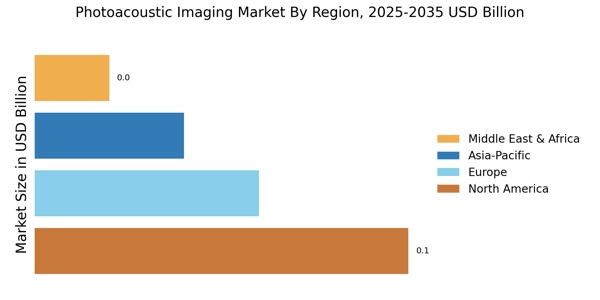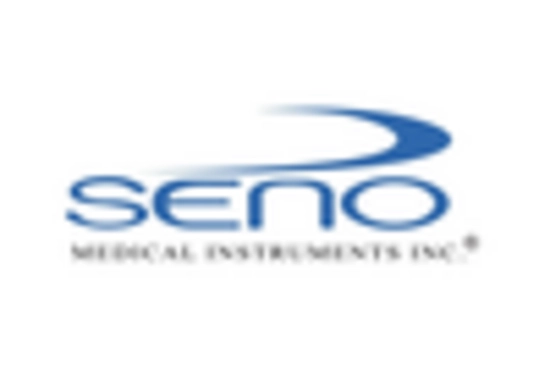Rising Incidence of Chronic Diseases
The Photoacoustic Imaging Market is significantly influenced by the rising incidence of chronic diseases, such as cancer and cardiovascular disorders. As these diseases become more prevalent, there is an increasing need for advanced imaging techniques that can provide early detection and monitoring. Photoacoustic imaging offers unique advantages, such as high spatial resolution and the ability to visualize vascular structures, which are crucial for diagnosing these conditions. According to recent statistics, the global burden of chronic diseases is expected to increase, leading to a heightened demand for effective diagnostic tools. This trend is likely to propel the growth of the photoacoustic imaging market, as healthcare providers seek innovative solutions to improve patient outcomes and reduce healthcare costs associated with late-stage disease management.
Expansion of Healthcare Infrastructure
The Photoacoustic Imaging Market is positively impacted by the expansion of healthcare infrastructure in various regions. As countries invest in improving their healthcare systems, there is a corresponding increase in the availability of advanced diagnostic tools, including photoacoustic imaging devices. This expansion is particularly evident in emerging economies, where healthcare facilities are being upgraded to meet the growing demand for quality medical services. The establishment of specialized imaging centers and the procurement of state-of-the-art equipment are expected to drive the adoption of photoacoustic imaging technologies. Furthermore, government initiatives aimed at enhancing healthcare access are likely to support the growth of the market, as more patients gain access to innovative diagnostic solutions.
Technological Innovations in Imaging Devices
The Photoacoustic Imaging Market is experiencing a surge in technological innovations that enhance imaging capabilities. Advanced imaging devices, such as high-resolution photoacoustic systems, are being developed, allowing for improved visualization of tissue structures. These innovations are likely to facilitate more accurate diagnoses and treatment planning. The integration of artificial intelligence and machine learning algorithms into imaging systems is also becoming prevalent, potentially increasing the efficiency of image analysis. As a result, the market is projected to grow at a compound annual growth rate (CAGR) of approximately 15% over the next five years, driven by these technological advancements. Furthermore, the introduction of portable and cost-effective imaging solutions is expected to broaden the accessibility of photoacoustic imaging, thereby expanding its application across various medical fields.
Increased Research and Development Activities
The Photoacoustic Imaging Market is benefiting from increased research and development activities aimed at exploring new applications and enhancing existing technologies. Academic institutions and research organizations are investing significantly in studies that investigate the potential of photoacoustic imaging in various fields, including oncology, neurology, and cardiology. This focus on R&D is expected to lead to breakthroughs that could expand the market's scope. For instance, recent studies have demonstrated the efficacy of photoacoustic imaging in monitoring tumor responses to therapy, which could revolutionize cancer treatment protocols. The growing interest in personalized medicine is also likely to drive further investments in this area, as tailored imaging solutions become essential for effective patient management.
Growing Awareness and Acceptance of Non-Invasive Techniques
The Photoacoustic Imaging Market is witnessing a growing awareness and acceptance of non-invasive imaging techniques among healthcare professionals and patients. As the medical community increasingly recognizes the benefits of non-invasive procedures, there is a shift towards adopting technologies that minimize patient discomfort and risk. Photoacoustic imaging, with its ability to provide detailed images without the need for invasive procedures, is gaining traction. This trend is supported by educational initiatives and professional training programs that highlight the advantages of such techniques. Consequently, the market is likely to experience growth as more healthcare facilities integrate photoacoustic imaging into their diagnostic offerings, thereby enhancing patient care and satisfaction.


















Leave a Comment